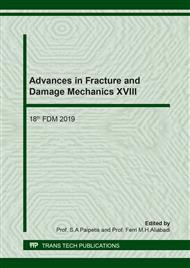p.275
p.282
p.288
p.294
p.300
p.306
p.312
p.318
p.324
TEM Study of Junctions between Martensite Laths and Changes in Microstructure of Low-Carbon Steel before LCF II
Abstract:
The joining points between martensite packets (laths) and their microstructure in low-carbon martensitic steel were TEM studied. In order to determine the real microstructure of the packet, martensite examinations were conducted before low-cycle fatigue (LCF) tests, considering the structure of the packets and types of their joining. The changes in microstructure occurred in the above places after austenite-martensite transformation were also analyzed. It was shown that after jointing some packets initiate arch-like contours in the laths, exhibiting a presence of local stresses. Several types of joints are considered, including the penetration of laths of one packet into that of neighboring one. It was revealed that the microstructure changes are exhibited in joining points without any external deformation, and result in the localized plastic deformation at LCF. It is assumed that microcrack initiation and commencement of fatigue failure of the material should be expected to happen just in these areas. All the above is explained from point of view of the peculiarities of martensitic transformation.
Info:
Periodical:
Pages:
300-305
Citation:
Online since:
December 2019
Authors:
Keywords:
Price:
Сopyright:
© 2020 Trans Tech Publications Ltd. All Rights Reserved
Share:
Citation:


